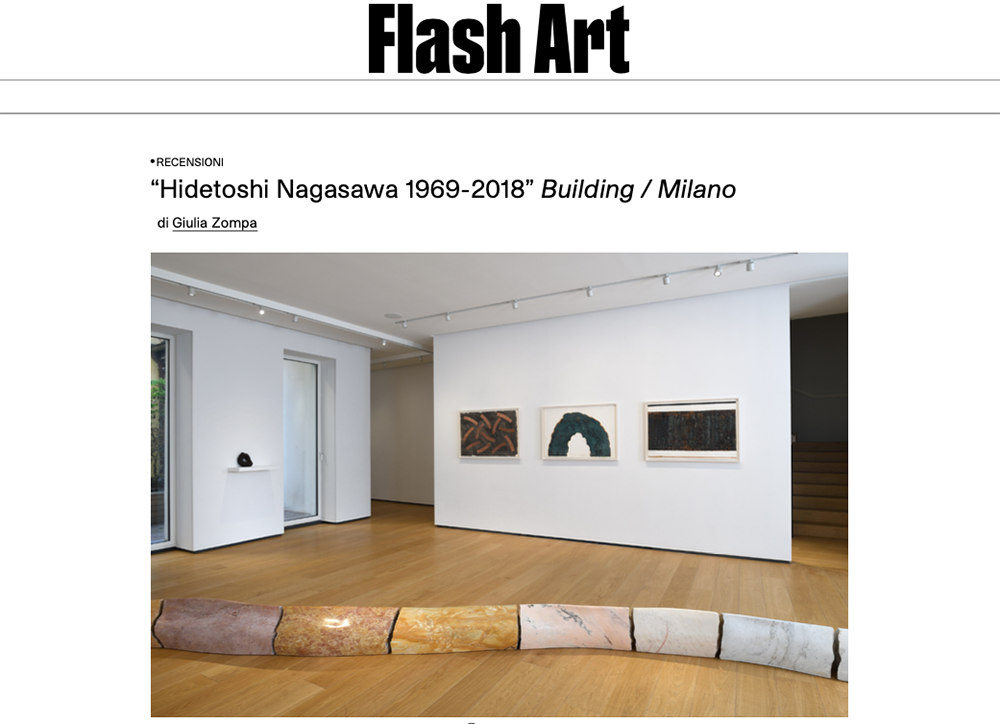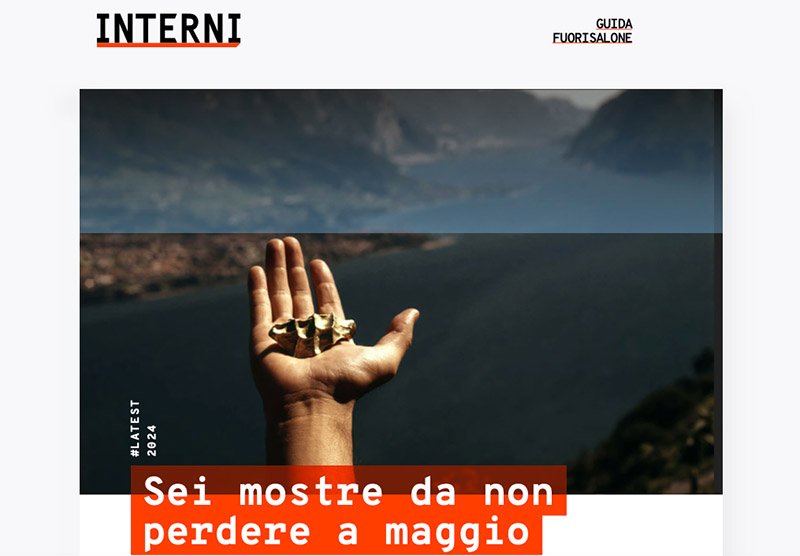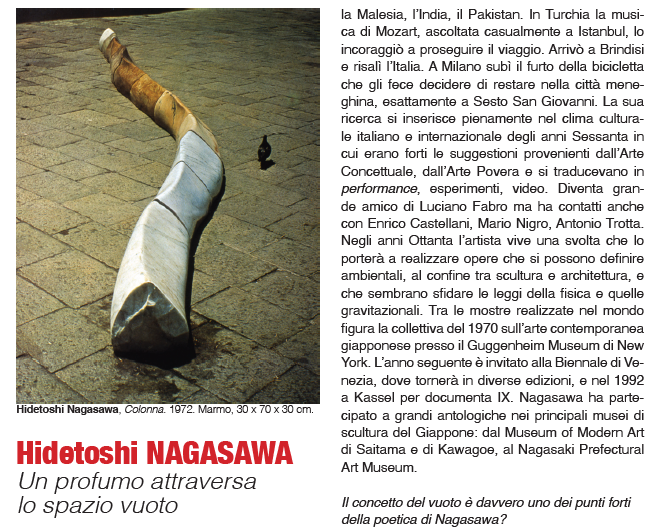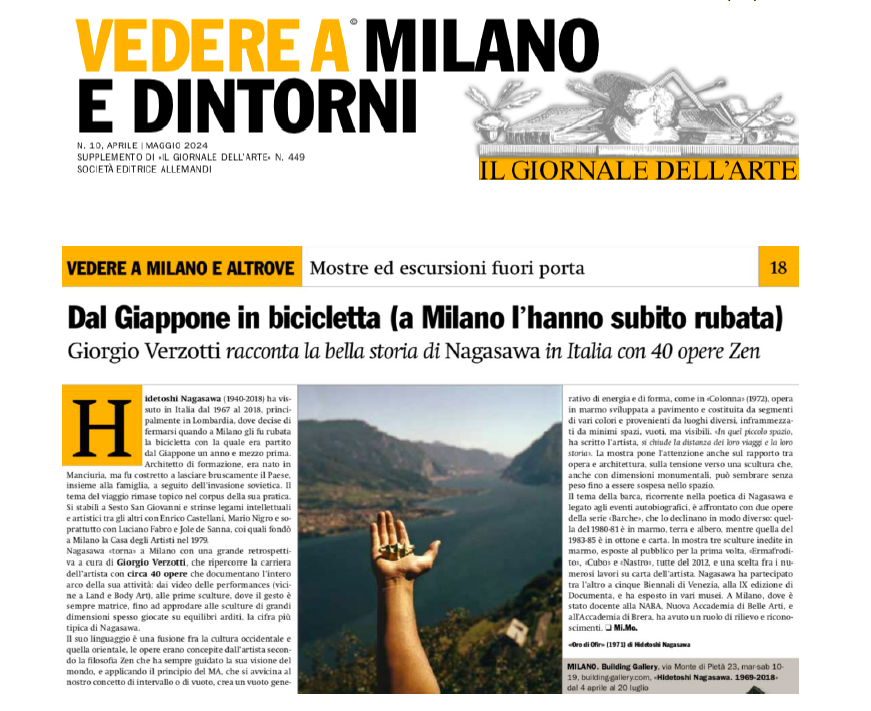Hidetoshi Nagasawa
Hidetoshi Nagasawa was born on the 30th of October 1940 at Tonei (Manchuria), where his father was serving as a medical officer to the troops of the imperial army. His childhood years were marked by the World War, circumstances that were inevitably to affect his poetics and his art. In 1945, following the invasion of Manchuria by the Soviet army, the Nagasawa family was forced to leave the country, together with the other resident Japanese civilians. Only after a tortuous journey lasting a year and a half did the Nagasawas arrive in Japan. Travel was to be a key facet of the artist’s character and was to mark much of his future output, providing him with motivation for reflection on the meaning of existence in time and space. Having settled in the Saitama prefecture, a short distance from Tokyo, the young Nagasawa began to attend high school where he showed interest in mathematics and painting; his studies then continued at the Tama Art University of Tokyo where he attended the Architecture and Interior Design course, graduating in 1963. During his years at university, he became aware of the various avant-garde trends such as Neo-Dada and encountered the Gutai Art Association thanks to various independent exhibitions organized every year by the Yomiuri newspaper at Ueno (Tokyo).
The appeal of the innovations of the avant-garde movements led him to reflect on and comprehend how the essence of art is to be found in action and spirit, even when this does not take concrete form in a particular object.
In the May of 1966, following his decision to widen his horizons, he left Japan on a bicycle, heading West in the direction of Europe. From Thailand he traversed Malaysia, India, Pakistan, Afghanistan, Persia, Iraq, Jordan, Lebanon, Syria, and then Turkey, in a gradual shift from East to West which brought him into contact with diverse cultures and civilisations. In Istanbul, he became aware of the music of Mozart playing on a small radio, thanks to which he realised he was by now on the threshold of the West. He decided to continue his journey and passing by way of Greece he eventually landed at Brindisi and from there ascended Italy, visiting cities and museums. He arrived in Milan in the August of 1967; such was the attraction of the city that he decided to settle in Sesto San Giovanni. It was from then on that he began to work alongside artists such as Enrico Castellani, Luciano Fabro, Mario Nigro, and Antonio Trotta.Between the late Sixties and early Seventies, his research was influenced by conceptual art and he found his first opportunities for exhibition in 1970 with the Françoise Lambert Gallery of Milan and the Solomon R. Guggenheim Museum in New York, where he participated in a group show of contemporary Japanese art.
From 1972, the year of his first participation in the Venice Biennale, the artist allowed himself to be seduced by plastic sensations and began reflecting on the meaning of sculpture, producing works of large dimensions in materials such as gold, marble and bronze.
His output from this period tackled the themes of the mark of the body and the abstract categories of space and time.Fascinated by the idea of metamorphosis, the artist also transformed paper, traditionally used as a support, into sculpture.
In 1979 he cofounded, together with Jole de Sanna and the sculptor Luciano Fabro, the Casa degli Artisti, a space for exhibitions, events, and artist residencies, which made a fundamental contribution to the Milan art scene. Between 1990 and 2002, Nagasawa was a lecturer at the Nuova Accademia di Belle Arti (NABA) in Milan; he also held courses at the Accademia di Belle Arti di Brera and at the Tama Art University in Tokyo. The artist died, at the age of 77, in 2018 at Ponderano (BI).
Nagasawa participated in five editions of the Venice Biennale (1972, 1976, 1982, 1988, 1993), Documenta (1992), the Paris Biennale (1973) and the Middelheim Biennale (1975). His works have been exhibited in solo and group shows at, among other locations, Tramway, Glasgow; Yorkshire Sculpture Park, Wakefield; Municipal Museum of Fine Arts, Kyoto; The National Museum of Modern Art, Osaka; Metropolitan Art Museum, Tokyo; The Museum of Modern Art, Saitama; Städtische Kunsthalle, Düsseldorf; Louisiana Museum of Modern Art Culture Center, Humlebaek; Museum Moderner Kunst, Vienna; Fundació Pilar i Joan Miró a Mallorca, Palma de Mallorca; Galleria Civica di Arte Contemporanea, Trento; Collezione Peggy Guggenheim, Venice; PAC-Padiglione d’Arte Contemporanea, Milan; Palazzo delle Esposizioni, Rome. Various examples of his work are conserved in private institutional collections of international standing, including the Museum of Modern Art Kamakura & Hayama, the National Museum of Modern Art, Osaka, the Takamatsu City Museum of Art and the Iwaki City Art Museum (Japan); the CaMusAC – Museo d’Arte Contemporanea, Cassino and MAMbo – Museo d’Arte Moderna, Bologna.














